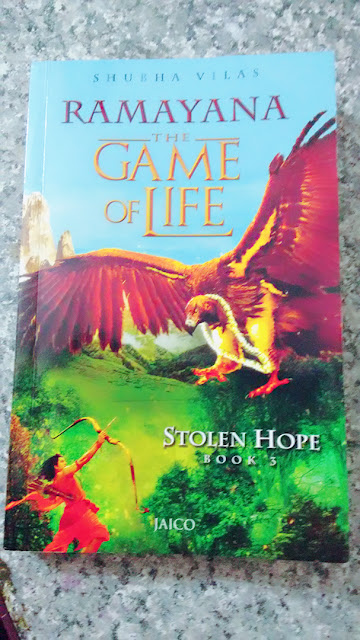Book Review : Ramayana -The Game of Life - Stolen Hope
Book : Ramayana
The Game of Life - Stolen Hope
Author : Shubha Vilas
Pages : 312
Publisher : Jaico
Ramayana ,The Game of Life- Stolen Hope is the Third Book in the Six Volume Series Written By Shubha Vilas . This Book Narrates the the Lesser known Stories of the Ramayana in a Language which is easy to Understand .Its Beautifully written describing every Character and Incident in very comprehensive way. This Book mainly Sheds light on the Episode of Encounter with Surpankha , Chasing the Golden Deer , and Abduction Of Sita . The Key Characters of this Book are Rama,Lakshmana , Sita , Ravana ,Surpankha , and Jatayu .
The Author of the Book highlights many not so widely known Stories that Sum Up the Journey of Rama, along with his Wife Sita and Brother Lakshmana,during the Exile Period. The Author narrates the Story Highlighting the Virtues ,Righteousness,Nobility and Ethics of Rama who is Considered as the Ideal Human or Perfect Man while giving every single detail of the Demon King Ravana, his Cruel ways , his lust for Women , His Unfair,Unlawful and Unjust ways of Living. Its also Throws light on the incidents where Ravana was Cursed by various Sages which is Quite Interesting to know.The Author Clearly defines the two forces , The Positive force Being Rama and his Righteous Ways and the Negative force being The Ravana and his Unethical ways and relates them to our Personal and Modern lives. The title is Justified as the book highlights the episode of Sita being Abducted by Ravana and also sheds light on the misery Rama faces when he discovers that Sita has gone missing .
This Book reflects the Mythology in a Simpler Way and bears the thoughts of the Author as footnotes which give a deeper insight into the Incidents and a greater perspective at looking and Understanding the Inner value of the Story than thinking of it as just a Story. The Author also draws out a Moral Lesson and shares his point of View about the respective Event as footnotes and relates the Values or Acts of the Character to our Daily faced Problems and our Modern ways of Living.
Here are the Few which I really Liked are :
- Curses are like the thunderstorms that bring in the rain of repentance and the rainbow of Realignment
- Historical travel create roadmaps
Historical Speeches create mindsets .
Historical habits create cultures
Historical mistakes create wisdom
- Real Beauty awakens the love in all hearts and envy in None
- All the Change is not Negative . Change Often Brings positive upgradation.
When a Caterpillar goes through Change ,it upgrades to a Butterfly
When a Seed goes through Change ,it upgrades to a Plant
When an Egg goes through Change ,it upgrades to a chick.
When external change reveals internal Stability ,it upgrades Others Confidence in You .
The fact I really like about this Book is that the Author has explained the Values and Moral lessons in a Very Poetic Style , They are also Inspiring and makes us give it a Thought .
Another thing which really struck me was the little Deer Print at the footer of the page that moves from its initial Position, at the second page of Chapter 1, little by little as we turn the Pages and move ahead in the Story and finally ,at the last page of the Last chapter , there is a print of the deer with a arrow pierced in its Body .So if we flip the pages really quick ,the print of the deer seems to be running. Its really fascinating .
I
The Book also includes Brief description of stories of First Book and Second Book at the Beginning right after the Acknowledgments under the Title "The Story So Far..".So while reading this Book one feels like going with the Flow.
And at the end , a Brief Introduction of the upcoming 4th book of Series is also included which increases the levels of Curiosity and Excitement.
People Interested in Mythology will enjoy reading it as it reveals many not so widely known Stories as well along with the Ramayana.


Sounds like a really good book with some excellent moral lessons.
ReplyDeleteYes !Its a great book :)
ReplyDeleteYes !Its a great book :)
ReplyDelete